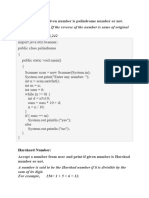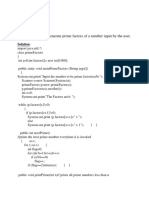0% found this document useful (0 votes)
16 views12 pagesSample Practical File
The document outlines several programs to check if a number is a Smith number, Evil number, Kaprekar number, Bouncy number, or Fascinating number, along with their respective algorithms and sample code in Java. Each program includes a detailed description of the number type, example inputs and outputs, and the algorithms used to determine the classification of the number. The document serves as a comprehensive guide for implementing these number classification checks in Java.
Uploaded by
chirodepduttaCopyright
© © All Rights Reserved
We take content rights seriously. If you suspect this is your content, claim it here.
Available Formats
Download as PDF, TXT or read online on Scribd
0% found this document useful (0 votes)
16 views12 pagesSample Practical File
The document outlines several programs to check if a number is a Smith number, Evil number, Kaprekar number, Bouncy number, or Fascinating number, along with their respective algorithms and sample code in Java. Each program includes a detailed description of the number type, example inputs and outputs, and the algorithms used to determine the classification of the number. The document serves as a comprehensive guide for implementing these number classification checks in Java.
Uploaded by
chirodepduttaCopyright
© © All Rights Reserved
We take content rights seriously. If you suspect this is your content, claim it here.
Available Formats
Download as PDF, TXT or read online on Scribd
/ 12























































































